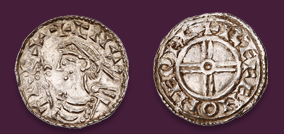
Auction: 7012 - Orders, Decorations, Medals & Militaria
Lot: 1096
The Great War Memorial Plaque to Captain E.K. Bradbury, ´L´ Battery, Royal Horse Artillery, Who Was Killed in Action Manning the Battery´s Last Remaining Gun Whilst Under Intense Enemy Fire at the Gallant Stand at Nery, Near Compeigne, France, 1 September 1914; He Was Awarded A Posthumous Victoria Cross For His Conspicuous Bravery Great War Bronze Memorial Plaque ´Edward Kinder Bradbury´, extremely fine, in original card envelope Estimate £ 2,500-3,000 V.C. London Gazette 25.11.1914 Captain Edward Kinder Bradbury (deceased) "L" Battery Royal Horse Artillery ´For gallantry and ability in organising the defence of "L" Battery against heavy odds at Nery on 1st September [1914]´ Captain Edward Kinder Bradbury, V.C., born 16.8.1881; educated at Marlborough and R.M.A., Woolwich; joined the Royal Artillery, May 1900; promoted Lieutenant, April 1901; served with the Imperial Yeomanry in South Africa, being present at Operations in the Cape Colony, 1902; served with the King´s African Rifles, February 1905- March 1907; Captain, February 1910. Battle of Nery On the night of 31.8.194, "L" Battery set up camp outside the village of Nery, twelve miles south-west of Compiegne. A Squadron of the Queen´s Bays was camped in the same field. The following morning, while the men were breakfasting, the camp was startled by the sound of guns very nearby. Soon the shells began to land amongst the teams harnessed up ready to march, and within two minutes there was not a single horse alive, and many men had been killed or wounded. Captain Bradbury, supported by Lieutenants Campbell, Mundy, and Giffard, each tried to bring a gun into action against the Germans, who had eight guns just 500 yards away. Captain Bradbury succeeded in getting his gun into action, and realising that there was no chance of the other guns being brought into action, ordered all to man his gun. Lieutenant Giffard was wounded in four places getting across to the gun, and so the detachment then consisted of just the three officers, Sergeant-Major Dorrell, Sergeant Nelson, a gunner, and a driver, everyone else having been killed or wounded. As they could not get an ammunition wagon alongside the gun, they had to carry up each round separately. Early in the battle Captain Bradbury had one leg taken off by a shell, but insisted on still directing the fire of the gun. Lieutenants Campbell and Mundy were both killed bringing up ammunition from the wagon. The ammunition in the first wagon having been used up, Sergeant-Major Dorrell, Sergeant Nelson, the gunner, and the driver, brought up ammunition from another wagon, which allowed Captain Bradbury to continue firing; soon after he was mortally hit by another shell, but Dorrell and Nelson remained at the gun until all the ammunition in both wagons had been used up, and succeeded in knocking out four of the enemy´s eight guns. At this point "I" Battery arrived, and with the help of a machine gun of the bays succeeded in silencing the remaining enemy guns, all of which were subsequently captured. Sergeant-Major (later Lieutenant-Colonel) Dorrell and Sergeant (later Major) Nelson were both awarded the Victoria Cross; Captain Bradbury´s followed a little later once it had been explained to his Commanding Officer that the V.C. could now be awarded posthumously! He is buried in Nery Communal Cemetery, France. The bullet-ridden gun is now part of the Royal Artillery Collection, Woolwich.
Sold for
£4,600




